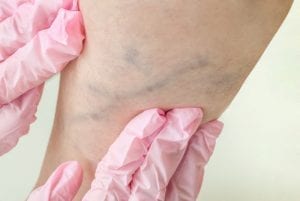
Pregnancy may precipitate or exacerbate a medical condition known as varicose veins.
This issue might occur or worsen during pregnancy, but there are treatment options available for women that are affected.
What Are Varicose Veins?
This health condition arises when the blood vessels known as veins become twisted or enlarged. Though veins located in any bodily region may be affected, the condition most often affects leg and foot veins because these areas support the body’s weight.
Associated Symptoms
The most common feature of this condition is the presence of bulging, twisted veins that are typically quite visible through the skin and to the naked eye. Sometimes, such veins might be recognizable due to a dark blue or purple color that other, healthy veins typically do not morph into.
In certain individuals, the unsightly features are the only physical manifestation. Others might experience additional symptoms, such as pain in or surrounding the impacted blood vessels, increased leg pain and swelling, itching around the influenced veins, discomfort upon sitting or standing for extended periods and bleeding around the impacted area.
In most instances, this ailment does not produce serious complications. That said, in some cases, they do occur and have the potential to manifest in problems like blood clots that could impede blood flow to the impacted region.
Pregnancy
Expecting women stand a greater chance of developing the condition for several reasons including the following:
 Bearing Excess Weight—Obviously, pregnant women carry more weight. Increased weight places greater strain on the legs and feet. Ergo, such a development puts added strain on impacted blood vessels and could leave them susceptible to damage and malformation.
Bearing Excess Weight—Obviously, pregnant women carry more weight. Increased weight places greater strain on the legs and feet. Ergo, such a development puts added strain on impacted blood vessels and could leave them susceptible to damage and malformation.- Decreasing Blood Flow to Pelvic Region—Though pregnant women experience increased blood flow, the elevated blood volume flows more towards the reproductive regions to support the health and well-being of the unborn child and away from the legs. These circulation disturbances could increase a woman’s susceptibility to bulging or malformed veins.
- Fluctuating Hormones—Pregnancy precipitates hormonal fluctuations. Varying bodily concentrations of specific sexual and reproductive hormones could cause structural changes within the veins.
Treatment Options
Fortunately, there are many therapeutic methods affected women might choose to employ such as the following:
- Avoid Standing or Sitting for Long Periods—Remaining sedentary for extended periods may exacerbate pain and decrease blood flow. It is important to move impacted limbs as much as possible to maintain regular blood circulation.
- Exercise as Much as Possible—Physical activity is critical to not only strengthening affected legs but for the stimulation of blood flow to surrounding muscles and tissues. That said, all pregnant women should consult with their physicians prior to engaging in any exercise regimen to ensure such activity will not pose any harm to the mother or her unborn child.
- Wear Maternity Clothing—Clothing specifically designed for pregnant women, such as maternity hosiery, place additional pressure on the legs and increase blood flow.
- Avoid an Excessive Intake of Sodium—Salt has been known to increase swelling of the extremities, especially the legs.
- Consult With a Healthcare Professional—Even though varicose veins do not typically pose any serious health threats, pregnant women are advised not to take any chances and to have the condition monitored by a doctor.


